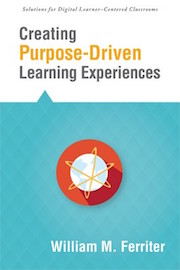How We Can Make Peer Feedback Effective
 by Bill Ferriter
by Bill Ferriter
Over the past few months, I’ve been doing a lot of thinking about the steps that we can take to move from a culture of grading to a culture of feedback in schools.
A lot of that thinking starts from the sense of paralysis that I see in my students, who — after years of being judged by everyone and everything from teachers to end-of-grade test scores — don’t always realize that the best learners are constantly assessing themselves.
So how do we develop that sense of intellectual agency in our students? How do we get to the point where the kids in our classrooms are ready and willing to accept personal responsibility for identifying just what it is that they know and can do?
My guess is that some part of the answer to that question starts by giving students tons of opportunities to give feedback to — and receive feedback from — their peers.
Why peer feedback advances self-assessment
Outside of simply increasing the amount of information available to learners, giving and receiving peer feedback reinforces the notion that students can be the primary authorities on the progress being made during any learning experience.
Ownership over “evaluation” and “assessment” are passed from the teacher to the learner – encouraging students to actively monitor their own growth rather than passively waiting to be rated by the adults in their lives.
But here’s the hitch: Because evaluation has always been the primary form of feedback given in our classrooms, students shy away from peer feedback because they equate it with “evaluation,” and that means “making judgments.” Making judgments can be socially intimidating.
The result is often students who give simple praise instead of targeted feedback in order to avoid hurting feelings. When students do offer some substantive feedback, they may have partners who refuse to act on good suggestions because their feelings have been hurt.
The solution I’ve been polishing with my friend Paul Cancellieri is to encourage students to make OBSERVATIONS instead of EVALUATIONS when giving feedback to one another.
Observations aren’t the same as evaluations
The difference — which you will have to introduce to students — is that observations are unbiased, concentrating on communicating tangible behaviors or characteristics that can be seen in the same way by others. Evaluations, on the other hand, include subjective interpretations that are often based on opinions.
Observations are also quick to deliver and quick to receive because they don’t require a lengthy justification for the rating given in an evaluation. Finally, observations eliminate the asymmetrical power dynamic that some students encounter during peer feedback (Price et al., 2010).
Because the student providing feedback is not judging or advising future action but rather sharing information as objectively as possible in an observation, the student receiving feedback doesn’t feel inferior – increasing the likelihood that feedback will result in action.
Here’s a good example of the difference
Need an example of what making observations instead of evaluations looks like in action? Check out this great Ron Berger video from EL Education, which highlights a lesson where students give descriptive feedback without making judgments to a peer:
Good stuff, right?
What makes the lesson we see in “Austin’s Butterfly” so powerful is that student learners knew that they weren’t expected to judge their partners. Instead, their only goal was to spot differences between the exemplar and Austin’s work product — a tangible task based on making observations instead of evaluations.
Stripping away judgments made the entire experience nonthreatening, building confidence in both the givers and receivers of feedback. That matters. Our goal should be to create classrooms where peers know that they can safely learn alongside one another.
As John Hattie explains: “Students learn most easily in an environment in which they can get and use feedback about what they don’t know without fearing negative reactions from their peers or their teacher.”
Doing so begins by focusing students on observations instead of evaluations when offering a helping hand to their peers.
Works cited:
Hattie, J. (2012). Know thy impact. Educational Leadership, 70(1), 18-23.
Price, M., Handley, K., Millar, J. & O’Donovan, B. (2010). Feedback: All that effort, but what is the effect?, Assessment & Evaluation in Higher Education, 35:3, 277-289

An advocate for PLCs, student-centered learning spaces, improved teacher working conditions, and teacher leadership, Bill has represented educators on Capitol Hill and presented at state, national, and international conferences. His three latest books (all published in May 2015) are Creating Purpose-Driven Learning Experiences; Teaching the iGeneration (2nd Edition); and How to Use Digital Tools to Support Teachers in a PLC.




































I currently teach 6th grade humanities and our curriculum is U.S. history. We also incorporate public speaking skills into our workload, and the student do individual and group projects which include an in class presentation of their work. In turn, as a group, we provide oral, concurrent feedback on content as well as presentation skills. The students will provide the feedback, meant to be constructive, and the recipients are comfortable hearing such feedback from their peers. I have found this to be very helpful, since we do not provide grades in our school. The fact that we also use public speaking hints (filler words, body language, projection, eye contact, etc.) also makes it more fun for the kids. I highly recommend that process.